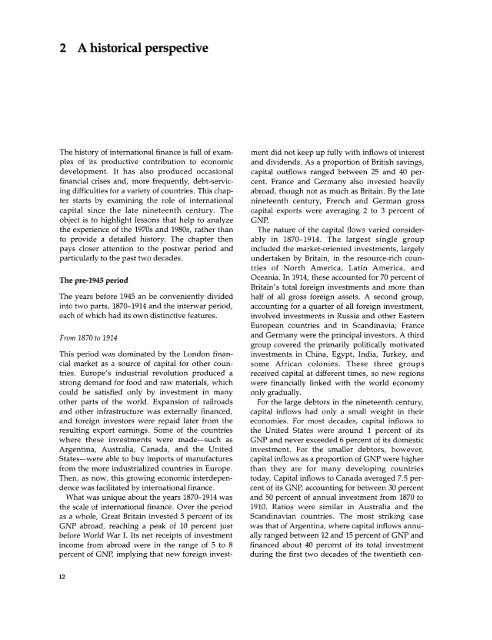World Bank Document
World Bank Document
World Bank Document
Create successful ePaper yourself
Turn your PDF publications into a flip-book with our unique Google optimized e-Paper software.
2 A historical perspective<br />
The history of international finance is full of exam- ment did not keep up fully with inflows of interest<br />
ples of its productive contribution to economic and dividends. As a proportion of British savings,<br />
development. It has also produced occasional capital outflows ranged between 25 and 40 perfinancial<br />
crises and, more frequently, debt-servic- cent. France and Germany also invested heavily<br />
ing difficulties for a variety of countries. This chap- abroad, though not as much as Britain. By the late<br />
ter starts by examining the role of international nineteenth century, French and German gross<br />
capital since the late nineteenth century. The capital exports were averaging 2 to 3 percent of<br />
object is to highlight lessons that help to analyze GNP.<br />
the experience of the 1970s and 1980s, rather than The nature of the capital flows varied considerto<br />
provide a detailed history. The chapter then ably in 1870-1914. The largest single group<br />
pays closer attention to the postwar period and included the market-oriented investments, largely<br />
particularly to the past two decades.<br />
undertaken by Britain, in the resource-rich countries<br />
of North America, Latin America, and<br />
The pre-1945 period<br />
Oceania. In 1914, these accounted for 70 percent of<br />
Britain's total foreign investments and more than<br />
The years before 1945 an be conveniently divided half of all gross foreign assets. A second group,<br />
into two parts, 1870-1914 and the interwar period, accounting for a quarter of all foreign investment,<br />
each of which had its own distinctive features. involved investments in Russia and other Eastern<br />
European countries and in Scandinavia; France<br />
From 1870 to 1914<br />
and Germany were the principal investors. A third<br />
group covered the primarily politically motivated<br />
This period was dominated by the London finan- investments in China, Egypt, India, Turkey, and<br />
cial market as a source of capital for other coun- some African colonies. These three groups<br />
tries. Europe's industrial revolution produced a received capital at different times, so new regions<br />
strong demand for food and raw materials, which were financially linked with the world economy<br />
could be satisfied only by investment in many only gradually.<br />
other parts of the world. Expansion of railroads For the large debtors in the nineteenth century,<br />
and other infrastructure was externally financed, capital inflows had only a small weight in their<br />
and foreign investors were repaid later from the economies. For most decades, capital inflows to<br />
resulting export earnings. Some of the countries the United States were around 1 percent of its<br />
where these investments were made-such as GNP and never exceeded 6 percent of its domestic<br />
Argentina, Australia, Canada, and the United investment. For the smaller debtors, however,<br />
States-were able to buy imports of manufactures capital inflows as a proportion of GNP were higher<br />
from the more industrialized countries in Europe. than they are for many developing countries<br />
Then, as now, this growing economic interdepen- today. Capital inflows to Canada averaged 7.5 perdence<br />
was facilitated by international finance. cent of its GNP, accounting for between 30 percent<br />
What was unique about the years 1870-1914 was and 50 percent of annual investment from 1870 to<br />
the scale of international finance. Over the period 1910. Ratios were similar in Australia and the<br />
as a whole, Great Britain invested 5 percent of its Scandinavian countries. The most striking case<br />
GNP abroad, reaching a peak of 10 percent just was that of Argentina, where capital inflows annubefore<br />
<strong>World</strong> War I. Its net receipts of investment ally ranged between 12 and 15 percent of GNP and<br />
income from abroad were in the range of 5 to 8 financed about 40 percent of its total investment<br />
percent of GNP, implying that new foreign invest- during the first two decades of the twentieth cen-<br />
12

















